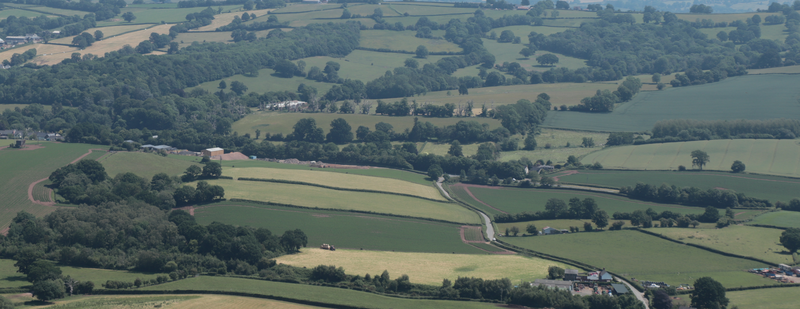Life is like a landscape. You live in the midst of it
but can describe it only from the vantage point of distance.
- Charles Lindbergh
Landscape ecology examines interactions of organisms and physical processes from a vantage point that allows perception of the spatial patterns they generate and by which they are constrained. It provides concepts and tools to support our understanding and management of change in landscapes inhabited by people, to ensure sustainability and to guide habitat conservation or restoration. Read on for a brief introduction to an all-encompassing scientific discipline that offers insights to practioners and policy-makers responsible for our natural environment and landscapes.
At its heart landscape ecology is ecological, concerned with relationships between living organisms and their physical environments. But as its name suggests, landscape ecology demands some notion of 'landscape', a slippery concept that depends on perception - both the vantage point of the observer and the context of the organisms under scrutiny. For example, the tiny landscape of the scurrying beetle (tens of square metres) is in stark contrast to the huge landscape of the soaring eagle (hundreds of square kilometres). Neither could comprehend the others', yet humans can observe and study both.
For most of us, a landscape is the perceived and lived environment of humans. And why not? Humans are ecological organisms too. Our human landscapes extend tens or hundreds of square kilometres and encompass forests, fields, fences, rivers, roads, ridges, and more. The boundaries of these landscapes might be defined by physical features (as in a watershed), by organismic definitions (as in the limit of a wetland), or by imaginary - but no less real - political divisions (as in between two counties). Humans are cultural organisms and the meaning they imbue on their environment, their landscapes, cannot be ignored. The preferred definition of landscape often depends on the questions or problems that the observers, and the inhabitants, are trying to answer or solve.
Hence, landscape ecology has roots in geography for concepts of land units and place, ecology for knowledge about ecosystems and habitat, planning for approaches that embrace communities in the development of action plans, and conservation for emphasis on restoration and protection. Although ecologists in some parts of the world might prefer to focus only on non-human organisms, living on crowded islands like those of the United Kingdom it's difficult to get away from the pervasive influence of human activity and its long history. In such regions, the interdisciplinary and holistic perspective of landscape ecology comes to the fore to aid understanding and management of social-ecological systems using insights from across the natural sciences, social sciences, and humanities.
Landscape ecology blossomed in the late twentieth century with advances in satellite remote sensing and geographic information systems, tools that help us to perceive landscapes. To paraphrase an aviator, you may live in the midst of a landscape, but you can only describe it from the vantage point of distance. Once patterns and change across the broad spatial and temporal scales of landscapes have been measured using technical instruments, it's then left to people to interpret and decide their importance and meaning. To understand and manage change in landscapes inhabited by people, we often need to draw on participatory planning methods that explore trade-offs and synergies of alternative decisions and actions. Many of these approaches have been developed in the pursuit of understanding and applying landscape ecology.
The all-encompassing scope of landscape ecology can perversely lead to it becoming invisible, and the influence of the discipline in many important policy and practice documents and reports is often not explicitly stated or articulated, even when present. The 2010 'Lawton Report' on Making Space for Nature exemplifies the spatial and holistic perspective of landscape ecology, arguing for land to be managed for multiple benefits while increasing connectivity of limited habitat. Similarly, and more recently, the designation of Nature Improvement Areas reinforces these ideas. Conservation organisations like the Wildlife Trusts and Royal Society for the Protection of Birds embrace landscape ecology through their living landscapes and futurescapes initiatives. The importance of the distribution of trees across landscapes for providing habitat and ecosystem services is exemplified by research initiatives like ‘Future of UK Treescapes’ and organisations such as the Woodland Trust. Just because you haven't heard of landscape ecology before, doesn't mean you haven't seen initiatives using its concepts and tools or been practicing or applying them yourself.
This has been just a brief intro to a discipline that can be traced to the 1930s, but which came to the fore in the late 20th Century. With nearly 100 years of history much has been written about the subject and other Landscape Learning pages point to further reading and learning resources. Our Landscape Connections webinar series presents and discusses advances in understanding and novel practical applications that continue to be developed. ialeUK - the UK chapter of the International Association for Landscape Ecology - aims to promote landscape ecology and to be as inclusive as the discipline is holistic. We welcome you to join us to learn more.
Text: James Millington and ialeUK (2024) CC BY-NC
Image: Caitlin Lewis and ialeUK (2023) CC BY-SA
Return to Landscape Learning homepage
Reference
Charles A. Lindbergh (1992). “Autobiography of Values”, Harcourt
